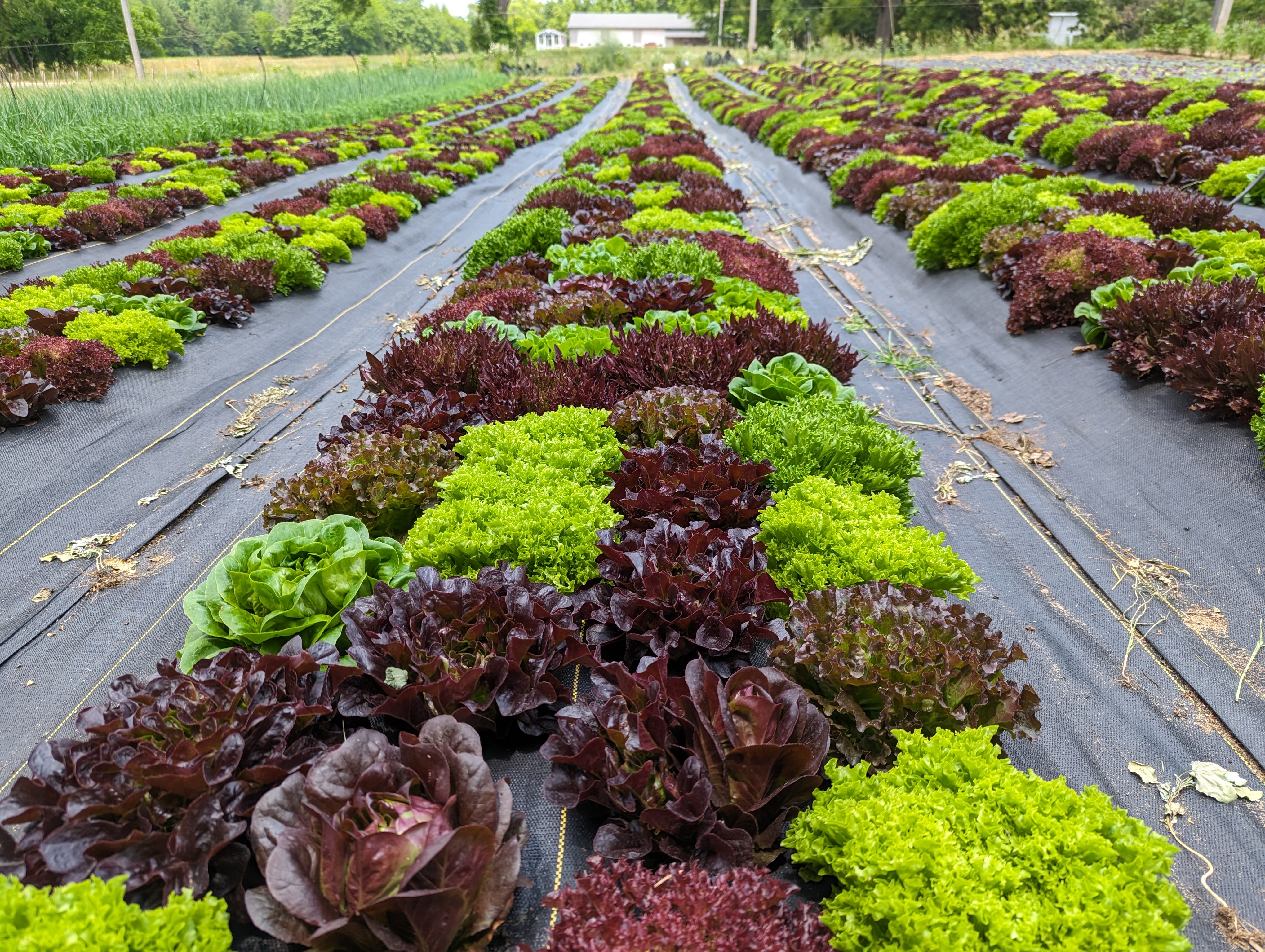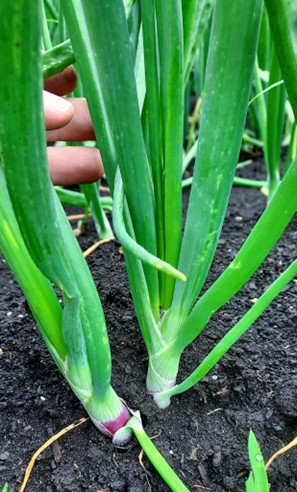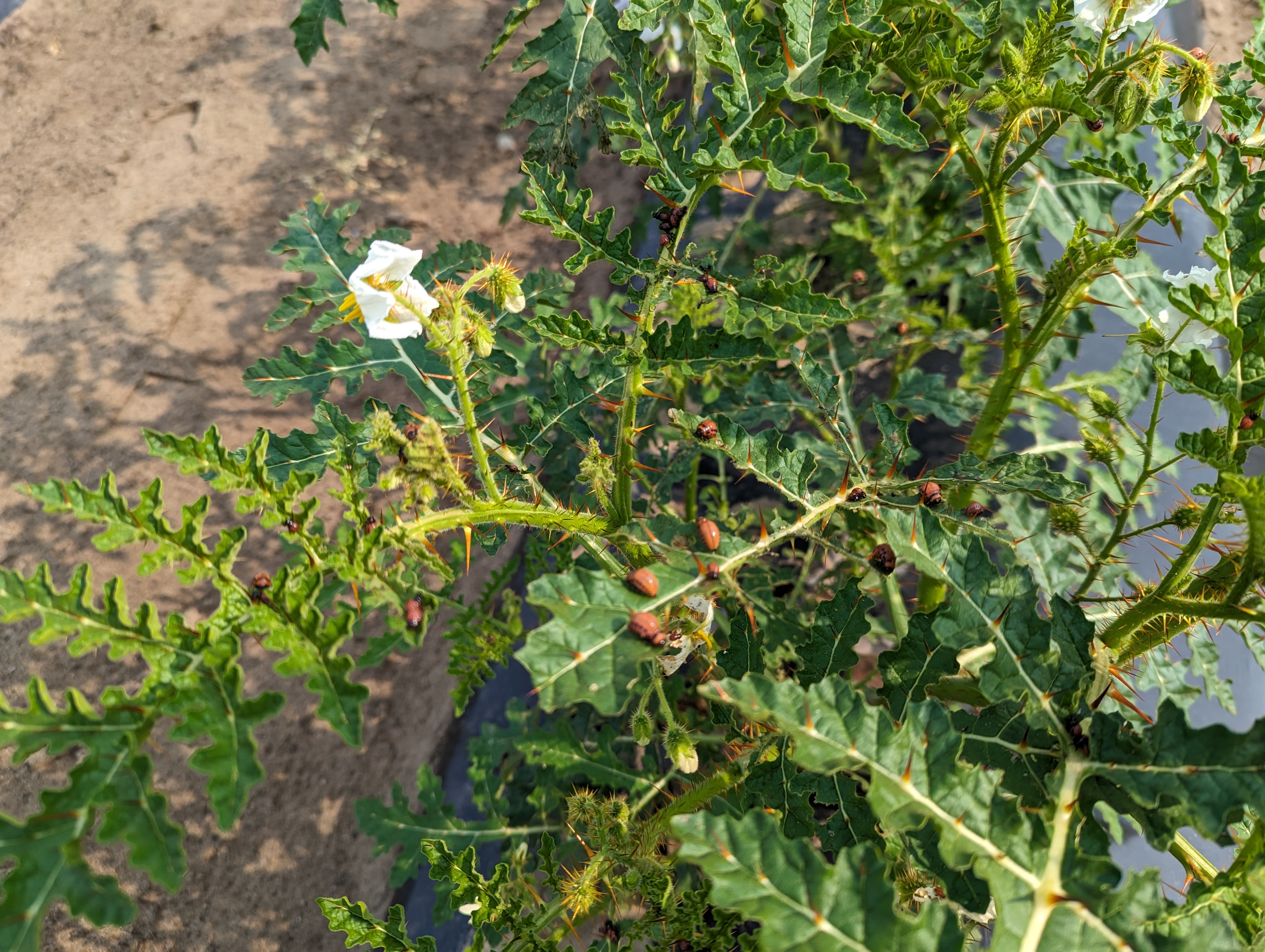Michigan vegetable crop report – June 28, 2023
More frequent rains, mid-summer harvests and ramping up crop protection.
Weather
Precipitation? What’s that! Thankfully, most of the state received rainfall, enough to help in the short term, but not enough to erase our 4- to 5-inch deficit.
The forecast calls for:
- Variably cloudy and hazy Wednesday, June 28. Scattered showers possible west Upper Michigan by evening.
- Scattered showers and thundershowers possible overnight tonight and Thursday, June 29, continuing on a daily basis through Sunday.
- High temperatures warming from the upper 70s to low 80s Wednesday to the 80s Thursday continuing into the weekend. Low temperatures in the 50s Wednesday warming to the upper 50s to low 60s Friday continuing through the weekend.
- Medium range outlooks generally call for above normal mean temperatures and above normal precipitation totals.
Weed of the week
Jimsonweed (Daturia stramonium) is a summer annual broadleaf weed in the Nightshade family. This conspicuous plant is identified by its toothed leaves, yellow or purple trumpet-shaped flowers, and spiky seed capsules. Every part of the plant is toxic to humans and livestock and this weed emits a detestable odor when leaf tissue is damaged. Jimsonweed can also serve as a host for various diseases (Septoria leaf spot, tomato yellow leaf curl virus, etc.) and insects (three-lined potato beetle, tomato hornworm, etc.) of Solanaceous crops.

Fortunately, there are numerous herbicides that control jimsonweed, depending on the crop. Controlling jimsonweed and other nightshade weeds (horsenettle, eastern black nightshade, etc.) can be tricky in Solanaceous vegetables. Post-emergent options in solanaceous crops are limited to products that have poor control of nightshades. Starting with a strong preemergence program using herbicides like Dual Magnum (s-metolachlor; tomatoes, eggplant, potatoes), Spartan (sulfentrazone; tomatoes), Reflex (fomesafen; tomatoes), Lorox (linuron; potatoes), Zidua (pyroxasulfone; potatoes) and Outlook (dimethenamid-P; potatoes) is beneficial when dealing with heavy jimsonweed/other nightshade pressure. Younger jimsonweed plants are also readily controlled by cultivation or flame-weeding, while larger escapes may require hand weeding.
2023 MSU Extension Southeast Michigan Farmer Survey
MSU Extension is pleased to announce our 2023 Southeast Michigan Farmer Needs Assessment Survey. This survey will gather information about your farm and your potential interest in learning more about various farm-related topics. The information gathered will inform future programs and educational opportunities offered by MSU Extension educators for agricultural producers in southeast Michigan. This survey will take approximately 10 minutes to complete and is accessible at the link below:
Take the 2023 MSU Extension Southeast Michigan Farmer Needs Assessment Survey!
Feel free to share the survey link with other growers. We welcome any participation in the survey in order to help Michigan State University Extension better serve its communities.
Crop updates
Asparagus
For purple spot, a first cover of chlorothalonil, azoxystrobin or mancozeb can be applied once cladophylls expand in shut down fields (read the June 14 report for fungicide information). Then, keep an eye on TomCast once sensors are out and we shift towards fern management. Keep in mind that disease can develop in dry conditions when dewpoints are high and temps are warm.
Scouting can help detect initial rust infections. Fields are most at risk if they are young and/or are next to lightly managed fields, which provide a source of inoculum. Tebuconazole is the most effective rust material, but protectants have some activity.
Irrigation may be important this year where accessible. Asparagus does not use much water during harvest, but water demand increases as fern develops and expands. Past work by the Brainard lab suggested Millenium primarily taps into water available in the top 24 inches of soil.
Carrots and celery
As of last Friday, June 23, leafhoppers were still minimal. So far aphids have not caused major issues but given the time of year, it’s good to keep an eye on scouting reports.
Variegated cutworm was relatively quiet—two in Decatur this week. Usually not as much a problem early as later.
Cole crops and leafy greens
Bok choy, head lettuce and cut-leaf greens are going to market on some farms. Diamondback moth populations jumped up this week in southwest Michigan, according to trap data from commercial scouts.

Cucurbits/pickles
Cucurbit planting continues across lower Michigan. Pumpkins and hard squash plantings have continued. Summer squash and cucumbers are being harvested.
Clade 2 downy mildew infects cucumbers and melons and spores from this subtype were trapped in Bay, Allegan and Saginaw counties last week. See the spore crops at the Downy Mildew News site. Stay on the lookout for this pathogen in pivot irrigated fields. Cucurbit downy mildew has been detected on cucumbers in southern Quebec on June 21, 2023.
Growers in a Phytophthora infested region may be in a tough place now, as for some fields surface waters may be the only source for irrigation. Read this article if you’d like to better understand the risks, and reference the Hausbeck lab’s plethora of fact sheets for control measures. These fact sheets contain a listing of the fungicides that have been found to be most effective based on years of field trials. If a particular fungicide is not listed on these MSU factsheets, it means that it has not been found to be effective and therefore is not recommended.
For hard squash and pumpkins, it can be difficult to successfully grow the crop in a site with a history of Phytophthora rot. Successful control relies on a two-pronged approach, which includes first keeping the plants alive and then protecting the fruit from rotting. MSU research has established that soil-applied fungicides are most effective in keeping the plant alive. Production systems that include raised plant beds and drip irrigation are well suited to applying registered fungicides through the drip tape to prevent root and crown rot. While these applications are important to keep the plants alive, the control is not extended to the fruit. Rather, the fruit needs to be protected using foliar sprays. The fungicide spray needs to come into contact with the fruit as it will not be absorbed by the leaves and translocated to the fruit. Using a plastic mulch to cover the plant beds and cover crops planted between the rows has been successfully used to prevent the fruit from resting directly on the soil that harbors the Phytophthora organism.
An important consideration when timing foliar fungicides to protect the fruit is the fruit stage. All hard squash and pumpkins are susceptible for the first 30 days post pollination. After this time, some hard squash varieties become less susceptible to fruit rot although fungicides are still recommended. Unfortunately, pumpkins remain equally susceptible from the time they begin to develop until the time they are harvested.
An important point to remember is that fruit are susceptible to Phytophthora even when they are very young. This means that it is important to be proactive in protecting the fruit from the very beginning. Sometimes it can be tempting to “save” the fungicide applications for when a fruit rot problem is in full swing. However, when fruit rot becomes evident and is ramping up, it can be nearly impossible to turn it around in time to avert large losses.
MSU is looking for anthracnose leaf and fruit rot and Phytophthora samples for research. Please reach out to us if you’ve got any potential infestations.
Fruiting vegetables
Field tomatoes and peppers are setting small fruit. Colorado potato beetles can be found on eggplant.
Despite recent rains, thrips populations remain high in many crops. Beetles and caterpillar populations are also building. If you have the capacity to drip irrigate, then you also have the capacity to put systemic insecticides at the root zone for plants to absorb. In many cases, this can protect beneficial insects as well. This North Carolina State Extension article, “Benefits of Applying Insecticides with Drip Chemigation,” is a great resource to reference for strategizing a drip chemigation approach to insect management. The pre-harvest intervals (PHIs) are often much longer for chemigated applications and require some planning.
MSU is looking for anthracnose fruit rot and phytophthora samples for research. Please reach out to us if you’ve got any potential infestations.
Onions
Already applied a FRAC 7 fungicide for Stemphylium? A Bravo (FRAC M5) and Tilt (FRAC 3) combination can be a good rotational partner that includes different modes of action. Read Hausbeck’s trial-based info on Stemphylium spray programs. Remember that strobilurins and mancozeb are not effective for Stemphylium.
Onion thrips control has been underway. It takes two Movento applications to really see the product’s impact. Cornell University developed a “choose your own adventure” approach for post Movento applications, all based on thrips numbers. If thrips numbers are below 0.6 per leaf, an application could be skipped. If they are moderate after Movento (0.6-1 per leaf), Agri-Mek could be considered. If they are a bit higher (1.2-2 per leaf), Minecto Pro could be an option. If they are high (more than 1.5 per leaf), either Exirel or Radiant could be used. Exirel could be used in situations where Radiant no longer seems as effective as it once was. Keep in mind that Agri-Mek and Minecto Pro have relatively long PHIs, and that Minecto Pro contains the same actives that are in Exirel and Agri-Mek. See the latest onion thrips recommendations from Cornell University in article format, or a graphical “choose your own adventure” spray format is here.
Regardless of what you choose after Movento, make a second application of that same product the next week if one is warranted. Then, avoid using that mode of action later in the season. This is important for resistance management. Onion thrips generations last about two weeks. If the same mode of action is applied three or more weeks apart, it could select multiple generations for resistance.
Grow onions from transplants? One nifty trick: You can sow multiple seeds per cell (e.g., two per cell) as a way to keep plant populations high with fewer plugs to place. The onions will push out from the cell and do just fine. Just adjust spacings accordingly.

Potatoes
Volunteer potatoes that were infected last year with late blight can overwinter to become a source of inoculum this year. This means controlling volunteer potatoes is an important part of managing this disease. Read more about control of volunteer potatoes. Overall volunteer potato survival was high this year.
With the increased precipitation, Colorado potato beetle activity may increase as the second generation begins to emerge. Colorado potato beetle is infamous for developing resistance to many of the insecticides thrown at it due to its diverse genome and ability to respond epigenetically to environmental toxins by upregulating defense mechanisms. A standard control practice is to rotate between insecticide modes of action using products listed in the Midwest Vegetable Guide. Natural enemies of potato beetles include larval/adult lady beetles and spined soldier bugs.


Root crops
For brassica root crops, cabbage maggot egglaying was happening at four of five sites Michigan State University Extension was monitoring, but there were no maggots this week. Based on degree days, the first summer peak has yet to come in west central Michigan. All this suggests that the spring generation of maggots is ending and developing into flies (this is why there are fewer maggots, they are pupating into flies or are already buzzing around). Flies are emerging and beginning to lay eggs. Read more about control.
Sweet corn
Succession plantings continue. First plantings of sweet corn are silking. Corn borers are being caught in southwest Michigan at about 20 per week.
Worried about sweet corn worms? The first caterpillar to think about is European corn borer. The first generation of caterpillars mainly does some whorl feeding in corn. That whorl feeding is a great way to determine if you have a local population that may require management. Typically, the second generation of this pest poses the greatest risk, as these moths lay eggs when corn ears are developing. You can track the timing of this pest using the Enviroweather model.
Corn earworm is the main driver of sweet corn spray programs. Because it is a migratory pest, its populations can change rapidly with large numbers migrating when frontal boundaries promote south to north airflow. Pheromone traps can help you determine what to spray for this pest and how often. Learn more in this video tutorial on using pheromone traps to monitor corn earworm. Currently, insectforecast suggests little to no risk of additional corn earworm migration in the coming days, but local traps are important.
Another pest that is showing up in ornamentals right now is spider mite. With the continued dry forecast, except to see these in crops at any time. The margins on corn make management decisions a little tougher. Keep in mind that sweet corn is not as long of a crop as field corn and so the long-term productivity of the leaves isn’t as important after silking. However, according to Utah State University, if the crop is near tasseling, the bottom third of the plant has symptoms of feeding, drought stress is apparent, it’s hot, predator populations are low, and you have a history of this pest, then it might be worth spraying. Chris Difonzo put together a mite cheat sheet for field crops, but the PHIs can be different for sweet corn and some are not labeled for sweet corn. For example, the PHI in sweet corn for Brigade is one day, Hero is three days, Oberon is five days and Onager is 28 days. Dimethoate is not labeled for sweet corn, and only Zeal with 6% and 31.7% etoxazole are labeled.
Strawberries
For many growers, it is time to renovate strawberries.
On-farm food safety
MSU and the conservation districts offer a program to visit your farm to go over your food safety program to provide critiques and comfort in a confidential fashion. You can then use these notes to make changes ahead of an actual inspection from the Michigan Department of Agriculture and Rural Development. If you are interested in an On-Farm Readiness Review (OFRR), please fill out this OFRR request survey to start the scheduling process—the sooner the better.
Fruit and vegetable growers may (still) be eligible for pandemic funds until July 14!
Fruit and vegetable growers may still be able to get funds using the Pandemic Assistance Revenue Program (PARP) and Emergency Relief Program (ERP); the application deadline has been extended until July 14, 2023. Farmers who had a 15% or more drop in revenue in 2020 can get most of that difference back under PARP, unless they already got that amount from other pandemic programs.
PARP is a good program for farmers who did not get caught up from other COVID-19 programs, often specialty crops growers. However, it is a complicated program to navigate. Please contact Chris Bardenhagen at 231-866-1959 or bardenh1@msu.edu or another member of the MSU Extension farm business management team to help you determine whether it makes sense to apply. Or contact your local Farm Service Agency (FSA) office directly. Please see our article on these programs and the United States Department of Agriculture’s PARP and ERP webpages.
Example: Under the PARP program, payments are based on whole farm revenue by calendar year. As an example, if a producer had $300,000 in allowable gross revenue in 2018, $275,000 in 2019, and 250,000 in 2020, the producer would qualify for PARP funds because 2020 revenue is more than 15% less than the 2018 revenue. The difference—$50,000—would be multiplied by the payment factor (let’s use 80% for this example, though some growers qualify for 90%). The resulting FSA payment of $40,000 would be reduced by payments received under certain pandemic assistance programs, if any. For example, a producer receiving $25,000 in CFAP 2 funds would still be eligible for a $15,000 payment.
Events
- June 29, 7–8 a.m., Field Crops Virtual Breakfast: Cercospora Leaf Spot Management In Sugar Beets
- July 5, 8:30 a.m. - 3 p.m., Ontario AgRobotics Field Tour, Part 1
- July 6, 7–8 a.m., Field Crops Virtual Breakfast: Strategies For Efficient Irrigation Water Use
- July 12, 10:00 am - 2 pm, Ontario AgRobotics Field Tour, Part 2
- July 13, 7–8 a.m., Field Crops Virtual Breakfast: Cover Crops After Wheat
- July 14, 12–1 p.m. CT: Farm Bill Friday Focused on Climate & Conservation
- July 17, 8:30 a.m. - 12 p.m., Biochar in Michigan Agriculture
- July 20, 7–8 a.m., Field Crops Virtual Breakfast: Tar Spot
- July 20, 9 a.m. - 1:30 p.m., In-Field and Edge-of-Field Conservation Practice Field Day
- July 27, 7–8 a.m., Field Crops Virtual Breakfast: Bugs And More Bugs!
- August 3, 7–8 a.m., Field Crops Virtual Breakfast: Farm & Truck Vehicle Regulations And Safety
- August 3, 8 a.m. - 4 p.m., 2023 Montcalm County Field Day
- August 10, 7–8 a.m., Field Crops Virtual Breakfast: How To Get The Best Out Of Your Drainage System
- August 17, 7–8 a.m., Field Crops Virtual Breakfast: "Hot Topic" Q & A Session
- August 24, 7–8 a.m., Field Crops Virtual Breakfast: Timing The Last Irrigation Application
- August 31, 7–8 a.m., Field Crops Virtual Breakfast: Setting The Stage For Record Breaking Wheat Yields
- September 7, 7–8 a.m., Field Crops Virtual Breakfast: Marketing Your Grain Crops
- September 14, 7–8 a.m., Field Crops Virtual Breakfast: Monitoring Nematode Resistance In Soybeans
- September 19-21, Farm Science Review
- September 21, 7–8 a.m., Field Crops Virtual Breakfast: Fall Weed Control
- September 27, Wooster, OH, Midwest Mechanical Weed Control Field Day
This work is supported by the Crop Protection and Pest Management Program [grant no 2021-70006-35450] from the USDA National Institute of Food and Agriculture. Any opinions, findings, conclusions, or recommendations expressed in this publication are those of the author(s) and do not necessarily reflect the view of the U.S. Department of Agriculture.



 Print
Print Email
Email




